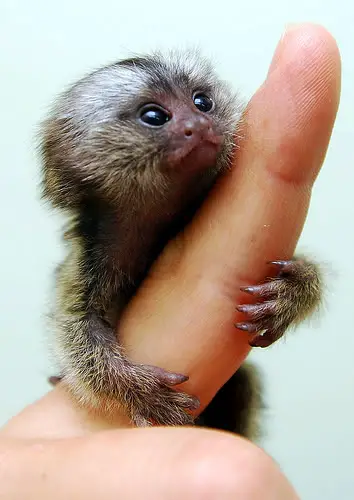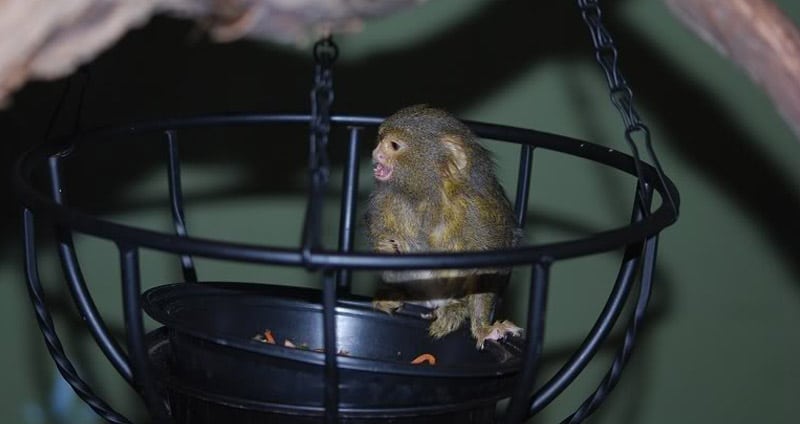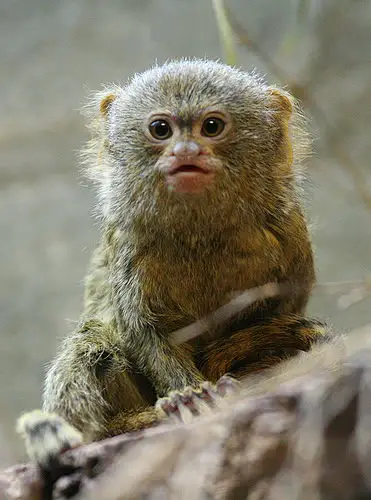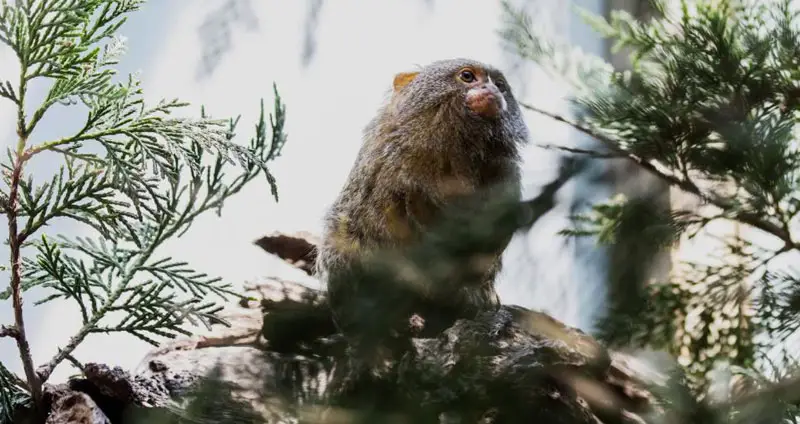Finger monkeys are creatures that are gaining a good amount of popularity in recent years, and it’s quite clear why that is. These tiny primates are absolutely adorable and incredibly fascinating to observe. Their small size makes them an apparent good candidate for pet ownership, and this has had a huge influence on their popularity. So, what exactly are these finger monkeys? Are they legal? How do you care for one? We’ll answer these questions and more inside of this detailed guide.
Table of Contents
What Is A Finger Monkey?
Believe it or not, the name “finger monkey” isn’t the scientific or technical term for these monkeys. Instead, the name was given to monkeys that are small enough to cling to a person’s finger once several pictures of them made their way around the internet. The most commonly-featured monkeys in these pictures were baby pygmy marmosets. So, when someone references a finger monkey, they’re likely talking about the adorable pygmy marmoset. This is the monkey that we’ll be referencing throughout the rest of this post.

This species of monkey is incredibly tiny, weighing only 3.5 ounces and measuring only 5 inches long without the tail. As of now, this is the smallest known monkey in the world. The family of primates that the pygmy marmoset belongs to, the Callitrichidae family, has a couple dozen species that are almost as small as the marmoset, though! The Callitrichidae family is also the only group of primates that mostly gives birth to twins!
Despite their size, finger monkeys spend their days much like other primates do. They’re native to the rainforests of South America, so they spend much of their day jumping between tree branches and snacking on Arabic Gum. Like other primates, finger monkeys are also having their habitats threatened by deforestation, so zoos and conservation groups are putting in an effort to help protect these tiny creatures.
9 Crazy Finger Monkey Facts
- Wild finger monkeys have a diet that primarily consists of tree sap. They acquire this sap by puncturing a tree with their sharp, vampiric teeth and drinking the sap as it flows out.
- Their fur has quite a few different colors. On their back, they tend to be grey, brown, or black, while their underside is yellow or orange. Their cheeks can have white flecks while their tails feature black rings. On their face, a dark line runs down the middle of their forehead.
- The pygmy marmoset is native to South America and is found in the countries of Brazil, Columbia, Ecuador, and Bolivia. They’re commonly moved around to other countries within South America to be kept as pets.
- They are the smallest known species of monkey, with adults averaging only about 5 inches in length and weighing 3.5 ounces.
- The lifespan of these monkeys is surprisingly long for how small they are. In the wild, finger monkeys live to be around 12, while captive finger monkeys frequently live to be 18-20.
- Tails of finger monkeys are generally twice the length of their bodies. So, a 6 inch finger monkey will have a tail that’s around a foot long!
- With such a light weight comes great jumping abilities. Finger monkeys can jump to a height of 15 feet in the air due to their bone structure and extremely light weight.
- While finger monkeys share many of the same abilities with other monkeys, they have one feature that stands out. A finger monkey can rotate its head 180 degrees in order to better survey its surroundings.
- In the wild, pygmy marmosets commonly live in groups of 6 to 9. This makes it necessary for owners to keep finger monkeys in groups of at least 2.
Finger Monkey Diet
Finger monkeys actually have a diet that is quite different from a lot of other primates but is still simple. In the wild, pygmy marmosets most commonly eat tree sap, gum, and resin — extracting these foods directly from a tree with their sharp teeth! On top of those strange foods, they also eat small insect, nectar, and whatever fruit they happen to stumble across.
In captivity, finger monkeys should be fed a diet that’s relatively close to their natural diet. Their bodies are designed to eat certain foods, so it’s important that they receive those foods and the nutrients that come with them. In general, finger monkeys require diets that are high in vitamin C and vitamin D3.
Most finger monkey owners provide their monkeys with a diet consisting of a mix of a healthy primate pellet, fresh fruits, and a bit of anything else that they have around the house. The most common of these additional foods are pasta, fish, vegetables, and even some small, safe insects. As long as the finger monkey is having their nutritional needs met, there’s a good amount of freedom in what you can feed them.

How Much Does A Finger Monkey Cost?
If you’re thinking about purchasing a finger monkey, the cost may be something that deters you. Despite their small size, finger monkeys can cost large amounts of money. Depending on factors such as size, age, gender, temperament, and the breeder, finger monkeys tend to sell for between $1,500 and $4,000+. While this is a large amount of money initially, that isn’t where the costs end. There are several other costs of ownership that you can’t forget about.
- Shipping | $100 – $200 | While it is possible to find a finger monkey near you, there’s a good chance that you’ll need to pay to have it shipped to you. As these creatures require specialty care in shipping, it’s not uncommon to spend well over $100 to have your finger monkey shipped to you.
- Cage & accessories | $200 – $400 | Sure, you may spend a lot of time with your finger monkey, but they’ll still spend a good amount of time in their cage. In order to purchase a cage that’s big enough for a pygmy marmoset and has all of their necessary accessories, you’ll easily spend a couple hundred dollars.
- Food | $50 – $75 monthly | While the diet of a finger monkey isn’t very strange, it can cost a decent amount when factoring in the diverse selection of foods. A quality monkey food plus fresh fruits, vegetables, and other snacks will cost a good amount monthly.
- Medical care | $100 – $200 per vet visit | These creatures are small, but that doesn’t mean that they don’t require medical care. A yearly checkup is absolutely essential for any finger monkey, and they should also be taken to a specialist if you observe something off about them.
Finger Monkeys As Pets
When most people are doing research on finger monkeys, they’re doing so as prospective finger monkey owners. Exotic animals are becoming more popular as pets, and finger monkeys appear to be some of the best exotic creatures to own. So how good are these tiny creatures as pets? Well, there’s some good things about them and some bad things. We’ll review both so that you have a thorough understanding of what to expect.
Pros
- Finger monkeys are tiny! These creatures only grow to be about 5 inches long as an adult, so they won’t take up too much space. They also can’t do too much harm to you or their surroundings.
- They’re very interesting primates and can provide a lot of entertainment within a short period of time.
- They’re very cute and will quickly become a staple in your house and your life in general.
Cons
- Pygmy marmosets are extremely energetic and clever. This requires you to provide them with constant companionship with yourself and another finger monkey to prevent them from becoming bored and destructive.
- They’re messy creatures despite their small size. Their cage must be frequently cleaned, and even then it won’t feel entirely clean due to their potent urine.
- As they age, these primates can get aggressive. Many finger monkey owners have reported being bitten and scratched by their pets. Feces throwing is also a problem some owners experience.
- They are prone to the exact same diseases that humans can contract, including the common cold, chicken pox, and even HIV. These can be a danger for both you and your monkey.
- You’ll spend a lot of money during ownership. The cost of a single finger monkey is quite high, but note that you should have a minimum of two due to the larger packs that they live in in the wild.
Finger Monkey Care Guide
When it comes to caring for a finger monkey, it comes down to three things. Those factors are diet, environment, and day-to-day care. All three of these things must be done very well in order to ensure the safety and health of your finger monkey.
The diet of a finger monkey isn’t very complex, but you need to know what you’re doing. Finger monkeys have specific dietary requirements that need to be met every single day in order to ensure that they stay happy and healthy. Instead of sticking to one food, it’s recommended that you feed your monkey a combination of different foods to diversify their diet. That combination should include a good primate biscuit, healthy fruits, and an assortment of grains, vegetables, rice, and even small insects. Make sure that their vitamin D3 and vitamin C levels are sufficient.

Although a finger monkey is small, it requires a fairly intricate setup that takes a good amount of time and money to put together. They should have a large cage that allows them to jump around freely and not feel cramped in the slightest. Within this cage, they should have access to swings and branches that allow them to play and get rid of any pent-up energy. After all, a tired finger monkey is a well-behaved finger monkey. This cage should be cleaned and disinfected regularly to keep your finger monkey healthy.
Aside from the cage, a finger monkey requires a lot of sunlight. Make sure that you place their cage in a location that gets a lot of natural light but isn’t in direct sunlight. The cage should also be placed in a location that gets some regular traffic but is separated from the excitement of a normal person’s daily life.
As for day-to-day care — you need to be present. Since these creatures are so social, energetic, and curious, you’ll need to spend a lot of time playing with them. If a finger money doesn’t get enough interaction, they’ll quickly grow bored and destructive. Present new challenges to them, be patient and kind to them, and be an overall caring owner. These are living, breathing, thinking creatures after all.
Finally, pay close attention to the health of your finger monkey. Because these creatures can develop the same illnesses as humans, they can come down with quite a few sicknesses. If you notice your monkey becoming lethargic or not acting right, take them to a specialist veterinarian immediately.
How To Buy A Finger Monkey / Are They Legal?
Back in the day, these creatures used to be incredibly difficult to come across. They were only desired by a few people, so there were no systems set up to easily get finger monkeys to people that wanted them. However, as time has passed, finger monkeys have gained quite a large amount of popularity in the world.
Now, you’re able to find finger monkeys at some local pet stores, with local breeders, or online on specialized marketplaces. Be very cautious when purchasing a finger monkey, though. Make sure that you’re getting your monkey from a reliable and ethical source that has healthy monkeys and treats their animals very well. You don’t want to support an operation that causes harm to these magnificent creatures.
As far as the legality of finger monkeys… it depends on where you’re located. Countries have specific laws in regards to primate ownership, so you’ll need to do research on your current place of residence. The United States is about split in half when it comes to primate ownership legality. You’ll also need to make sure that there’s no rules preventing primate ownership within your city, county, or even neighborhood.
Should You Buy A Finger Monkey?
It depends. If it’s legal to own a primate in your place of residence and you can provide them with the proper care that they require, then there’s no reason why you wouldn’t be able to purchase a finger monkey for yourself. However, just because you can doesn’t mean that you should.
Owning a primate, even one as small as a finger monkey, is a huge responsibility. These creatures are extremely energetic and social creatures that require several hours of close interaction every single day to remain happy. They can also be aggressive and cause quite a few problems for owners.
You should also note that captive finger monkeys regularly live to be 20 years old. While it may seem like a good idea to bring a finger monkey into your life now, you need to think about how things will be two decades from now. You should only purchase a finger monkey after at least a year of contemplation and after you’ve settled down into a place that you don’t see yourself leaving anytime soon. If your life is uncertain or doesn’t have a good routine, it isn’t fair to your finger monkey to bring them into that scenario.
So, ultimately, we can only recommend getting a finger monkey if you’ve been wanting one for a very long time, you know you can provide it with all of the care that it needs, and you’re willing to dedicate almost 2 decades of your life to it. If this sounds like you, a finger monkey could make a great adorable addition to your family.

